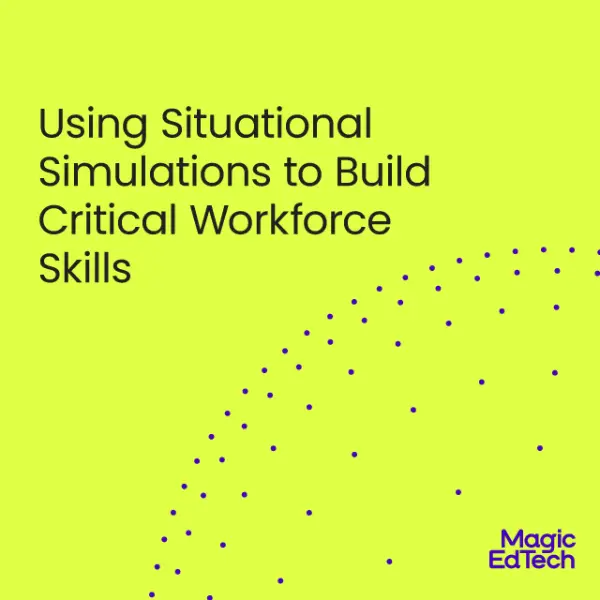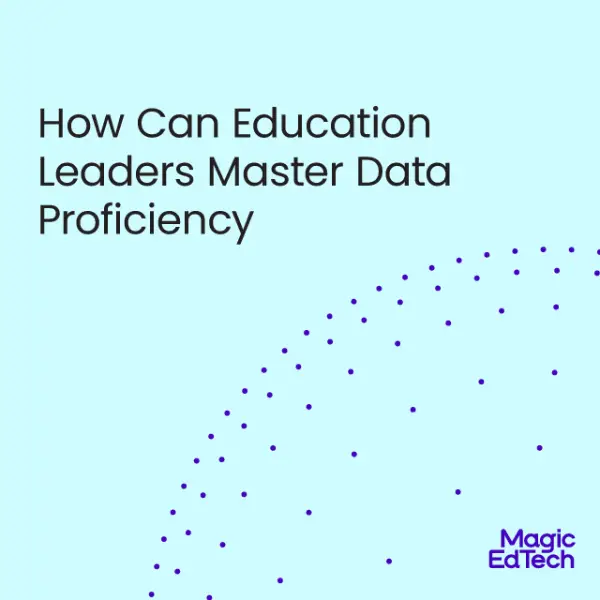Resilient Learning Infrastructure That Empowers Educators
- 18 October, 2023
- Reading Time: 6 mins
Digital infrastructure for education is just as necessary as physical infrastructure. Digital infrastructure includes everything that makes digital systems work, like the internet, devices, and software. And it’s not just about technology; it’s also about how people use these resources. This includes ensuring everyone can connect, keeping data secure, ensuring different systems can work together, and helping people learn how to use digital tools.
Think ahead to meet the needs of tomorrow’s learners
One challenge with the edtech infrastructure in schools and higher ed institutions is that a lot of it was built and set in place over a decade ago. These archaic systems aren’t equipped to keep pace with technology. So if you’re thinking about updating your institution’s digital infrastructure, think ahead!
For example, advancements in cloud technology for learning and Generative AI will play a huge role in edtech over the next 5 years. Cyberattacks will get more sophisticated, making cybersecurity a pivotal area for concern. Your digital systems must be able to meet and tackle the challenges of tomorrow. They should also be designed to be financially sustainable and able to grow as education changes.
Challenges in Implementing Effective Tech Infrastructure for Teaching
Here are some common challenges that institutions face and how to overcome them by investing in good edtech infrastructure.
1. Organization and Time Management for Teachers
Many educators have had to embrace digital technology without formal training, and juggling the demands of a classroom while staying up-to-date with new online tools can become overwhelming.
How to address this challenge:
-
- EdTech Integration: When selecting digital tools or apps, prioritize those that are well-integrated rather than fragmented. This integration will make it easier for teachers to access and manage their resources efficiently.
- Single Sign-On (SSO): Implement a Single Sign-On system to simplify login access for educators. This streamlines the process and reduces the time and effort required for managing multiple logins.
- Intuitive Features: Opt for products with intuitive features that are easy to navigate. Teachers will appreciate tools that don’t require extensive training and can be used seamlessly in their daily routines.
- Educator Collaboration: Look for products developed in collaboration with educators. Such products are more likely to address the specific needs and challenges faced by teachers, making them more likely to be adopted effectively.
- Offer tech support and training: Ensure that both teachers and students are well-versed in using the technology. Providing technical support and training programs can mitigate the distractions caused by technical issues.
2. Addressing the Techquity Divide
Not every school has the resources to provide the high-tech devices or steady internet speeds that online learning sometimes demands. Many learners within a classroom may be using the Wi-Fi simultaneously. Even for schools with strong Wi-Fi speeds, this may pose audio or video challenges, making it very distracting for the instructor.
How to address this challenge:
- Invest in Device Equity: Work to ensure that each student has access to a high-quality device, such as a laptop or tablet. This can involve initiatives to provide devices to learners who can’t afford them.
- Enhance Internet Connectivity: Collaborate with local internet service providers or government agencies to improve internet access in underserved areas. This may involve initiatives to provide internet connectivity to students’ homes or offer public Wi-Fi hotspots.
- Implement load balancing: Schools can optimize their Wi-Fi infrastructure by employing load-balancing techniques to distribute network traffic evenly. This helps prevent slowdowns or disruptions when many students are online simultaneously.
- Asynchronous Learning Options: Develop a mix of synchronous and asynchronous learning methods. Not all learning activities need real-time interaction and providing recorded lessons and materials can reduce the demand for real-time internet access.
- Content Compression and Optimization: Learning institutions can work on compressing and optimizing multimedia content to reduce the data and bandwidth requirements, making it easier for students and teachers to access educational materials even with limited internet speeds.
3. Helping Teachers Maintain Inclusivity
EdTech is often unsupported by assistive technology for learners with disabilities. This means unequal access to learning resources leading to some learners being left out.
How to address this challenge:
- Accessible Content Creation Tools: Invest in or develop content creation tools that enable educators to create accessible materials. These tools should have features for adding alt text to images, closed captions for videos, and compatibility with screen readers.
- Integration of Assistive Technologies: Ensure that EdTech systems can seamlessly integrate with assistive technologies such as screen readers, braille displays, and voice recognition software. This allows learners with disabilities to access and interact with the technology effectively.
- Universal Design Principles: Encourage the adoption of universal design principles when developing or selecting EdTech. These principles emphasize creating technology and materials that are inherently accessible to a wide range of users.
- Accessibility Procurement Policies: Mandate that all EdTech products and services used in the institution comply with Web Content Accessibility Guidelines (WCAG) or other relevant accessibility standards. Ensure this compliance is a part of procurement criteria.
- Regular Accessibility Audits: Conduct regular accessibility audits of EdTech platforms to identify and rectify any accessibility issues. This can involve working with experts in accessibility or disability services.
4. Privacy and Security:
With digital technology, there are always concerns about student data privacy and cyberattacks.
How to address this challenge:
- Secure Vendor Contracts: When working with EdTech vendors, include strong data security and privacy clauses in contracts. Ensure that vendors are following industry-standard security practices. Choose edtech software and applications that are born secure and built using best practices.
- Data Encryption and Secure Storage: Implement robust data encryption protocols for both data in transit and at rest. Ensure secure storage solutions to protect sensitive student information from unauthorized access.
- Multi-Factor Authentication (MFA): Require MFA for all system logins to add an extra layer of security. This ensures that even if login credentials are compromised, access remains restricted.
- Data Privacy and Security Protocols: Develop and enforce robust data privacy and security protocols to safeguard student data. Comply with data protection laws (e.g., GDPR, FERPA) and create policies for ethical data use.
5. Learning Analytics Implementation
Many educational institutions struggle to effectively implement learning analytics due to data silos, privacy concerns, and lack of comprehensive strategies. This can hinder the potential benefits of data-driven decision-making and personalized learning experiences.
How to address this challenge:
- Invest in Cloud Solutions: Build a scalable tech infrastructure capable of handling growing data volumes. Cloud-based solutions can be cost-effective and flexible.
- Data Integration and Interoperability: Invest in systems that facilitate data integration. Ensure that various educational platforms and tools can seamlessly exchange data to create a unified view of student performance.
- Data Standards and Frameworks: Adopt common data standards and frameworks for learning analytics. This ensures data consistency and allows for easier analysis and interpretation.
- Predictive Analytics and AI: Implement predictive analytics and artificial intelligence (AI) algorithms to identify at-risk students and provide timely interventions to support their learning journey.
- Real-time Analytics Dashboards: Create real-time analytics dashboards for educators and administrators. These dashboards provide instant insights into student progress, allowing for immediate action.
What Efforts Are Being Made at the Administrative End To Support Teachers With Strong Digital Capabilities?
Digital tools can help teachers do their jobs better, make school operations smoother, and improve how things generally work. Many schools and institutions now understand how essential digital tools are. Schools are working to ensure their learning environments are robust and can handle challenges.
Some efforts that the schools are making in sync with government support include
- Professional Development: Providing ongoing training and workshops to enhance digital skills and teaching strategies. This may involve offering courses, webinars, or access to digital resources.
- Technology Integration Specialists: Employ specialists or coaches who work directly with teachers to integrate technology effectively into the curriculum and classroom.
- Access to Resources: Ensuring teachers access up-to-date digital tools, software, and educational platforms that can enhance their teaching and improve student engagement.
- Technical Support: Technical support and troubleshooting assistance are offered to help teachers address any issues they encounter when using digital tools.
- Infrastructure Investment: Ensuring schools have robust internet connectivity, devices, and IT infrastructure to support teachers in their digital endeavors.
It’s important to understand that ESSER funding is primarily earmarked for addressing issues related to school infrastructure, with a specific focus on bolstering digital infrastructure and safety measures. The U.S. Department of Education has recognized the challenges associated with the supply shortages and has responded by extending the flexibility of how funds can be allocated to improve digital infrastructure within institutions.
Institutions must recognize the critical importance of future-proofing digital infrastructure to ensure they remain at the forefront of education.




